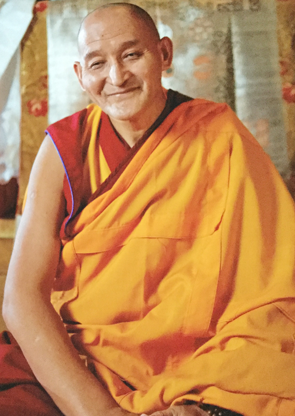Geshe Jampel Senge teaching on:
The Tree of Faith: a Self-Exhortation
by Dromtönpa Gyalwé Jungné
Saturday 28th June 10 am to 3:30 pm
Lharampa Geshe Jampel Senge has kindly agreed to give another whole day teaching for us at TKSL. For those who weren't able to attend the teaching he gave in March, more information about Geshe-la can be found here: http://tashichoeling.org.
The text that Geshe-la will be using to teach is called The Tree of Faith: a Self-Exhortation by Dromtönpa Gyalwé Jungné. It is one chapter in a larger text known as The Book of Kadam. This is a book of the core texts of the Kadam traditon translated into English by Thupten Jinpa. Dromtönpa is said to have been the prinicipal disciple of the great Lama Atisha who brought the second wave of Budhism to Tibet.
Please email tksl@goodfortunetrust.org to register for this event and receive an e-copy of the text.
Here is some more infromation about THE BOOK OF KADAM: THE CORE TEXTS [from the introduction]
The Kadam school, which emerged in the eleventh century from the teachings of the Indian master Atiśa and his principal disciple, Dromtönpa, is revered for its unique practical application of the bodhisattva’s altruistic ideal in day-to-day life. One of the most well-known sets of spiritual teachings stemming from Atiśa and Dromtönpa is a special collection of oral transmissions enshrined in the two-volume Book of Kadam (Bka’ gdams glegs bam). The texts presented here include the core texts of The Book of Kadam, notably the twenty-three-chapter dialogue between Atiśa and Dromtönpa that is woven around Atiśa’s Bodhisattva’s Jewel Garland. Sometimes referred to as the “Kadam emanation scripture,” The Book of Kadam is undisputedly one of the greatest works of Tibetan Buddhism. This volume contains (1) Atiśa’s Bodhisattva’s Jewel Garland, (2) the twenty-three-chapter Jewel Garland of Dialogues, (3) Dromtönpa’s Tree of Faith: A Self-Exhortation, (4) Elucidation of the Heart-Drop Practice by Khenchen Nyima Gyaltsen (1223–1305), (5) four selected chapters from Dromtönpa’s birth stories, (6) two brief verse summaries of The Book of Kadam, one by the Second Dalai Lama (1476–1542) and the other by Yongzin Yeshé Gyaltsen (1713–93), and (7) Sayings of the Kadam Masters, compiled by Chegom Sherap Dorjé (ca. twelfth century).
Although the Kadam school no longer exists as an autonomous lineage within Tibetan Buddhism, its teachings have become fully incorporated into the teachings of all four major schools, especially the Geluk school. One of the major legacies of the book was the embracing throughout Tibet of Avalokiteśvara (the buddha of compassion) and the goddess Tārā (the buddha of enlightened activities) as special divinities connected to Tibet, laying the foundation for what later came to be the institution of the Dalai Lamas.



























